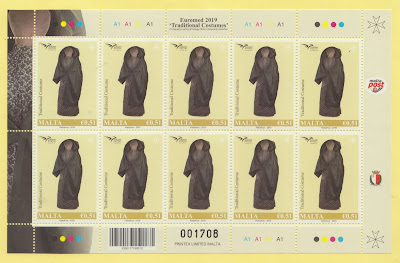Philatelic Postage stamp issue – EuroMed Postal ‘Traditional Costumes’ MaltaPost will be participating in a EuroMed Postal Union philatelic issue, themed ‘Traditional Costumes’ with a set of three stamps. Traditional Maltese clothes were primarily made from cotton. In fact at the time most of the available land was used to cultivate cotton. The natural colours of cotton were white, beige and brown, which is reflected in the choice of colours found in typical traditional Maltese costumes. The stamps will be issued in a sheet of 10 stamps, with each stamp measuring 44mm x 31mm, with a comb perforation of 14.0 x 13.9 and bearing the Maltese Cross watermark. The sheets measure 185mm x 114mm and were produced by Printex Ltd in the offset process. The issue consists of 400,000 of the €0.28 stamp, 40,000 of the €0.51 and 40,000 of the €1.25 stamp. The stamps set is designed by MaltaPost Creative Studio and the photography is by Heritage Malta. This philatelic issue will be available from all Post Offices in Malta and Gozo as from Tuesday 9th July 2019.
Technical Details:
Date of Issue: 09 July 2019
Design: Malta Post p.l.c.
Photography: Heritage Malta
Perforation: 13.9 x 14.0 (comb)
Process: Offset
Sheet: Set of three stamps
Denominations: €0.28, €0.51, €1.25
Watermark: Maltese Crosses
Sheet Size: 185mm x 114mm
Stamp Size: 31mm x 44mm
The Postal Union for the Mediterranean (PUMed), forms part of the Universal Postal Union, and marks the Mediterranean region as a political, economic and social area.
Members within PUMed have come together to develop projects that will help each postal operator keep up with the challenges of the market. PUMed was established in March 2011 with its headquarters in Malta.
PUMed will be issuing a joint stamp issue bearing a common theme 'Traditional Costumes'.
Daily life in early modern Maltese history was very much dependent on economic traits, mainly divided in two distinct spheres. The Grand Harbour area was centred on maritime activity which along various centuries was fuelled by trade and industry. Strategic importance and wartime replenishment also generated years of considerable prosperity. The rest of the archipelago remained heavily reliant on agriculture up to the mid-twentieth century. This dichotomy finds its imprint in dress, since like all other forms of art, costumes reflect the society which produces them.
Date of Issue: 09 July 2019
Design: Malta Post p.l.c.
Photography: Heritage Malta
Perforation: 13.9 x 14.0 (comb)
Process: Offset
Sheet: Set of three stamps
Denominations: €0.28, €0.51, €1.25
Watermark: Maltese Crosses
Sheet Size: 185mm x 114mm
Stamp Size: 31mm x 44mm
The Postal Union for the Mediterranean (PUMed), forms part of the Universal Postal Union, and marks the Mediterranean region as a political, economic and social area.
Members within PUMed have come together to develop projects that will help each postal operator keep up with the challenges of the market. PUMed was established in March 2011 with its headquarters in Malta.
PUMed will be issuing a joint stamp issue bearing a common theme 'Traditional Costumes'.
Daily life in early modern Maltese history was very much dependent on economic traits, mainly divided in two distinct spheres. The Grand Harbour area was centred on maritime activity which along various centuries was fuelled by trade and industry. Strategic importance and wartime replenishment also generated years of considerable prosperity. The rest of the archipelago remained heavily reliant on agriculture up to the mid-twentieth century. This dichotomy finds its imprint in dress, since like all other forms of art, costumes reflect the society which produces them.
Traditional Maltese clothes were primarily made from cotton. In fact at the time most of the available land was used to cultivate cotton. The natural colours of cotton were white, beige and brown, which is reflected in the choice of colours found in typical traditional Maltese costumes. Sheep's wool was less used for clothing, but popular for domestic furnishing particularly blankets and sheets.
One costume in particular was the 'Ghonella', sometimes referred to as 'Faldetta'. This garment was a traditional Maltese headress for women which covered most of the body. This headress was generally made from black silk however there were other variations made from cotton, woven in different colours and style.










No comments:
Post a Comment